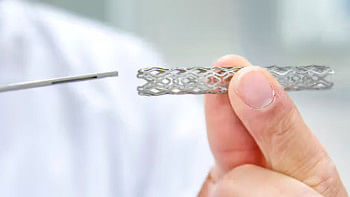Winning the fight against corrosion

Do you know why the Statue of Liberty looks blue-green in colour? Originally the statue was dull brown, reflecting the natural colour of its copper plates. It turned blue-green due to a natural weathering process in which air and water acted on the copper plates. With this anecdote, Professor Saiful Amin explained the science behind corrosion.
He added that the electrochemical oxidation of metal occurs in reaction with an oxidant typically in presence of moisture. This is a triangle. Rusting, the formation of iron oxides, is a well-known example of electrochemical corrosion. To prevent corrosion, we have to break this triangle by removing one of the legs. The whole idea of corrosion prevention is based on such a scheme. For example, we apply paint to keep metal away from water and air. This is a widely used corrosion-prevention technique.
Professor Amin continued that large structures such as steel bridges, locomotives and trains require regular painting to protect them from corrosion. Oils and lubricants are generally used to cover the moving metal parts from air. These are costly and harmful to the environment. To reduce costs and the harmful effects of these elements, and to ensure durability, we need to focus on design. The surface area should be kept to a minimum by using box-shaped units instead of using smaller sections of angular or complicated geometries. New generation paints are more durable. We have also seen the introduction of stainless steel in building infrastructure. Stainless steel provides better protection against corrosion. Further improvement has happened in this sector, and now we have weathering steel, which is also called paintless steel. In this technology, some metals are used which, after being corroded, create a stable dense surface that prevents corrosion from propagating deep inside the steel. This is a beneficial use of corrosion. We have seen some projects in Bangladesh that are using weathering steel. This is a benchmark of development. Currently, a local steel company is producing epoxy-coated rebar, which is a reinforced bar with upgraded corrosion-prevention technology.
In reference to the protection of concrete structures from corrosion, Dr. Amin emphasised the use of quality concrete. In most cases, due to the poor quality of concrete, cracks develop in a structure in a more intensive way than expected in design. This greatly reduces the lifetime of the structure. Using corrosion resistant steel reinforcement, and increasing concrete density and the thickness of concrete around steel reinforcement, are some simple approaches that can be followed to prevent corrosion. He underlined that we have to invest in the prevention of corrosion to save the whole structure. The investment must be made at the initial stage. Though this additional investment decision is often dictated by the financial capacity of an owner, s/he should also consider the lifecycle cost of the infrastructure, opined the expert.
He elucidated the concept of the lifecycle cost of an infrastructure as an assessment of the total cost of the structure, which includes initial investment and operational and maintenance costs throughout its lifetime. It may increase initial cost but result in significantly reduced operating and maintenance costs in the longer term. Investment in prevention of corrosion is a part of this long-term thinking. Dr. Amin said that we have to make people aware about this good practice.
He also discussed the environmental factors of corrosion. In reference to the government's ongoing development works in coastal areas to exploit the potentials of the blue economy and maintenance of the infrastructure across the coastal belt, he emphasised the necessity of seriously considering the airborne salinity that readily and largely promotes corrosion in metals.
There are also other sources that exacerbate corrosive effects. Air pollution is one of these. He also pointed to the use of domestic and industrial wastes in landfills as an emerging concern. The gases released from such wastes have the potential to increase the rate of corrosion in metals and electronic equipment installed in the structure. Therefore, proper waste management is strongly connected to the prevention of corrosion.
Professor Amin concluded with the hope that both public and private sector will work together to create awareness about various aspects of corrosion and take necessary measures to protect our valuable structures.

 For all latest news, follow The Daily Star's Google News channel.
For all latest news, follow The Daily Star's Google News channel. 



Comments